The use of social media:
TORL used social media as a core element of its overall media strategy. The campaign created involvement and participation and a sense of purpose in supporters funnelled through social networking technologies. Posts, tweets and videos coincided with the overall communications strategy for the campaign, reinforcing the campaign’s message(s). The campaign connected with people giving them an easy and accessible way to show their support for change. The social media strategy consistently presented a focused message and vision for change.
The campaign altered content and tone for different social channels based on its audiences. It used facebook as a tool to engage potential supporters and encourages them to take action through the action age (www.turnofftheredlight.ie/action). Through face-book, the campaign targeted specific groups of existing supporters with specific messages, and/or target potential supporters. Through the action page individuals contacted their local TDs asking for their support for the change being advocated. At periods throughout the campaign, key partners were given the tasks of promoting the campaign through social media to their followers and supporters. This increased traffic reaffirmed engagement with supporters and encouraged additional followers to the campaign.
The cyclical nature of the campaign was also a key strength for its growth and success. Personal stories from the core partners generated media interest, which grew public involvement. This gave the campaign credibility and increased awareness of our goals with stakeholders, leading to increased membership. This fed the campaign’s knowledge-base, leading in turn to more media attention. Each point in this cycle provided an opportunity for political engagement: media content, public engagement and partner contacts all lead to awareness on the part of politicians at a local level.
Almost without exception every press release landed on target – with the topics varying from the coalition growing, to international moves towards similar laws in other jurisdictions and/or new data from the front-line services such as Immigrant Council or Ruhama or any new research in the area.
In the digital age, social media became a cornerstone of the campaign. In its latter years, this meant a need for an increase in imaginative visual content that could portray a political message in a moment. Survivor stories, captured in videos, quotes and images, were at the centre of this campaign.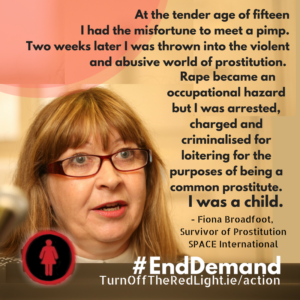
These were supported by partner messages to capture the varied members of the coalition. We asked partners to send in short clips explaining why they joined Turn off the Red Light, to give us a bank of content for use.
The campaign had a monthly reach in excess of 120,000 on Facebook and Twitter. It had over 6,500 Face-book ‘likes’ and approximately, 3,850 Twitter followers. Supporters were kept up to date about campaign progress and key milestones through social media. At key events and time-frames, social media is used to articulate important activities, resulting in the campaign ‘trending’ at various key strategic points. The campaign also used advertising as a strategic tool, using social media to communicate its messages.
Tinder campaign: –
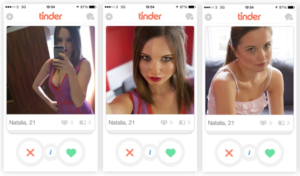
For example, the campaign utilised the matchmaking mobile app Tinder to confront users with the realities of sex trafficking in Ireland. Tinder has become an extremely popular app in Ireland, and it provided the campaign with a unique, innovative and stand out way of communicating the issues faced by women involved in sex trafficking. The campaign communicated the brutal reality of sex trafficking in Ireland with Tinder profiles telling victims’ stories and inviting users to swipe left on pictures. Irish ad agency ‘eighty twenty’ used models to create Tinder profiles for three characters, Natalia, Ana and Kim. As a user flicked through each woman’s pictures, they see her transform from a composed, made-up beauty to a badly beaten victim. This was the first use of Tinder in Ireland for a campaign of this nature and one of the first such uses globally. It received huge media attention, nationally and globally, and won a number of adverting awards.
Real Men Don’t Buy Girls:-
‘Real men don’t buy girls’ was another aspect of TORL’s social media campaign. The message of the campaign was to highlight sex-trafficking and the early age at which many girls enter into prostitution. High profile men from Irish music, sport and the arts lent their support to create greater awareness amongst young men about trafficking both in Ireland and abroad.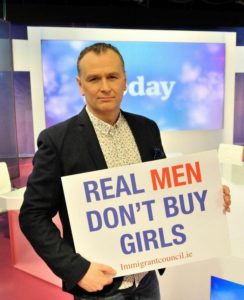
Justin Timberlake, the singer was one of the first to support the US campaign against child sex trafficking. We asked Irish male celebrities to join him in his support. We also asked men from all aspects of Irish life to support this aspect of the campaign.
Support for the campaign could be done through downloading a download a poster, getting a friend or colleague taking a picture holding it and posting the picture on Facebook and/or Twitter. The campaign also included a wristband for sale, and for use in promoting the campaign.
Dáithí Ó Sé. From Monday we are inviting guys across Ireland to sign up to this simple message and take a stand against sex trafficking
Link to :- https://www.youtube.com/watch?v=V3FbgKpUZNg
Promotional materials and advertising campaign:
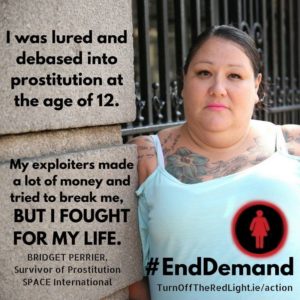 From the outset, it was agreed that there must be a balance struck between representing the experiences of abuse and vulnerability in prostitution, and the need to avoid showing those affected by prostitution as weak or victims. Therefore, images and statements were chosen where possible to contrast the inner strength of the women affected and the stark reality of their experiences.
From the outset, it was agreed that there must be a balance struck between representing the experiences of abuse and vulnerability in prostitution, and the need to avoid showing those affected by prostitution as weak or victims. Therefore, images and statements were chosen where possible to contrast the inner strength of the women affected and the stark reality of their experiences.
Making direct eye contact with the camera, and thus the viewer, we aimed to challenge audiences to reflect on the reality of what too many women, children and men were going through in Ireland.
Branding for the campaign put women at its centre, and chose colours that reflected its serious nature: red and black.
Anna was 14 –The most successful imagery of the campaign was that of “Anna was 14”, a simple graphic showing a young woman with the words “14: The age Anna was first exploited in prostitution” followed by “She’s not the only one. You can help stop this” and a website link. Evidence showed that girls under 18 were in brothels alongside adults. Also, many of the women in prostitution in Ireland entered the sex trade as girls. When the Irish Government tasked the cross-party Justice Committee to review laws on prostitution, a public awareness campaign was launched entitled “Anna was 14”. While people had varying assumptions about adult women in prostitution, there is wide acceptance that child prostitution is always exploitation; is always rape.
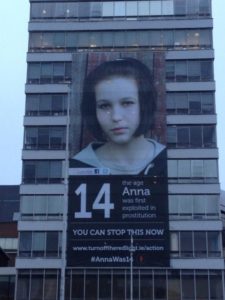
To highlight the grey areas between child and adult, an older girl was asked to model as ‘Anna’, a fictitious character that represented a typical profile of young women presenting to frontline partner organisations.
By challenging the audience to take action, by visiting a website and contacting their representatives to seek change, the ad campaign ensured that the public must face the reality that society as a whole is complicit in the sex trade, and thus has the power to change it. While you may not have known this is going on, now that you do – will you act?
This campaign raised awareness not only of the campaign, but also about the sex trade as a whole. Focussing on the exploitation of underage girls in the trade and forcing the viewer to challenge them meant the poster brings shock, urgency and the chance for action.
The poster was featured on billboards around Ireland, and most notably as a banner on Dublin’s Liberty Hall, a famous trade union building on the city’s quays. Such prominent visibility led to wide media coverage, public debate, and helped contribute to a shift in public opinion around the need to enact the Nordic model by putting the spotlight on those who enabled such abuse.